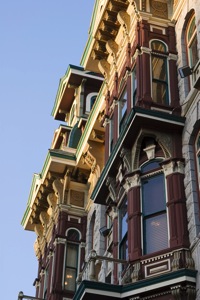
San Diego has a rich history and is considered to be the birthplace of California. There are many areas with historic homes and buildings, but one of the oldest neighborhoods in San Diego is the Gaslamp Quarter. This district was developed as the “new town” after the original settlement of San Diego, which we now know as “Old Town” lost its momentum.
In 1850, in an effort to establish a town on San Diego’s waterfront, San Franciscan William Heath Davis began developing land near the foot of Market Street. For his own family Davis built a pre-framed lumber “salt box” house, one of the first residences in town and one of the oldest surviving structures in San Diego. After an economic depression Davis’ venture failed and his town became known as Rabbit-Ville after its principal inhabitants.
In 1867, Alonzo Horton arrived in San Diego from San Francisco. After looking over Old Town, he decided that the best place for the city to develop was down by the waterfront. Determined to build a new downtown on the site of Davis’ failure, Horton purchased at auction about 800 acres of land on the waterfront for approximately 33 cents an acre. Two years later, he paid $4,000 for an additional 160-acre parcel.
In 1869, Horton spent about $50,000 to build a wharf at the end of Fifth Avenue which made this and the adjacent streets the backbone of the fast developing city. On March 24, Horton sold $5,500 worth of commercial and residential lots in only one day. His new town had begun to boom.
In 1870, after building Horton Hall at Sixth Avenue and F Street the first public theater, with 400 seats, Horton opened the town’s first bank.
In the 1880s, San Diego’s booming prosperity attracted prostitutes and gamblers, including Wyatt Earp, who ran three gambling halls. Gradually, San Diego commerce began moving north of Market Street. The abandoned area to the south became a red-light district known as the Stingaree. By 1887 there were over 350 prostitutes working in 120 different bordellos. By the way, a bordello is just a fancy name for a whorehouse.
In 1888, San Diego’s 1880s real estate boom ended. By the end of the decade the population had dropped from 40,000 to 16,000.
In 1894, Alonzo Horton made a deal the city fathers couldn’t refuse. He sold them a valuable half-block of land for $10,000, stipulating that it must remain a park forever. Under the agreement, the city agreed to pay Horton $100 a month with no interest and no down payment. In the event of Horton’s death, the city would acquire the property outright. The city fathers underestimated Horton’s endurance. In April 1903 a spry, 89-year-old Horton cashed the final payment. Today Horton’s park fronts Horton Plaza and has been renamed Horton Plaza Park.
In 1903, Madame Ida Bailey opened her own fancy parlor house at 530 Fourth Ave. called the Canary Cottage, a pale yellow house set behind a white picket fence. She and her girls “entertained” downtown’s well-groomed gentlemen with fat wallets, including the mayor and chief of police.
In 1909, having lost most of his properties through tax sales and foreclosures, Alonzo Horton died at the Agnew Sanitarium. On his 95th birthday he told a newspaper reporter, “It’s the most beautiful place in the world to me.” Ironically, the same year in San Leandro, California, William Heath Davis also died, financially impoverished.
In 1912, influenced by a wave of citizen morality, police raided the Stingaree and arrested 138 prostitutes operating out of sleeping rooms on the upper floors of the district’s buildings. Two agreed to reform their ways, 136 promised to leave the city. The next morning, however, one changed her mind. The other was found to be insane. With the red lights of the Stingaree officially turned off, San Diego became unpopular as a liberty port for the Navy. 797 men aboard several warships voted for San Francisco as their favorite liberty port. San Diego got only 17 votes.
Following World War II, the suburbs outside of downtown San Diego experienced an influx of new residents and businesses, leaving the Gaslamp Quarter as the home of tattoo parlors, seedy bars, pawn shops and locker clubs. Adult businesses, including peep shows, massage parlors and adult bookstores continued to converge on the Gaslamp for the next 30 years.
In 1974, business and property owners banded together, under the leadership of former City Councilmember Tom Hom, and petitioned the City Council for aid in the revitalization of the Gaslamp Quarter. The San Diego City Council provided $100,000 to rehabilitate the Gaslamp Quarter, as well as to develop guidelines to preserve the district’s historic aesthetic. A few years later, the Gaslamp Quarter was listed on the National Register of Historic Places.
In 1982 developers and restoration experts were encouraged to continue restoring the Gaslamp’s Victorian buildings, leading to one of the most profound joint urban preservation efforts in San Diego history. In 1989, the Gaslamp archway over Fifth Avenue was completed.
The Gaslamp Quarter has successfully transformed into a premier shopping, dining and entertainment district with over 200 restaurants, bars, nightclubs and lounges. There are also countless boutiques, art galleries and shops. The Gaslamp has established itself both as an electric playground and as an elite urban destination. It is truly a special place in San Diego to appreciate and enjoy!
Trent St. Louis is a licensed Real Estate Agent
and a member of the National, California and
San Diego Association of Realtors. You can reach Trent at trent@tns.net or at his office in Hillcrest, The Metropolitan Group. DRE#01273643.










